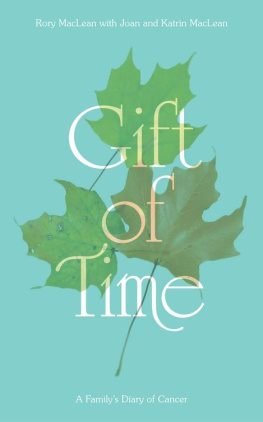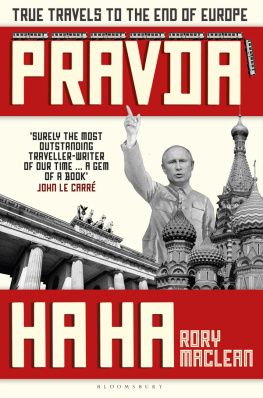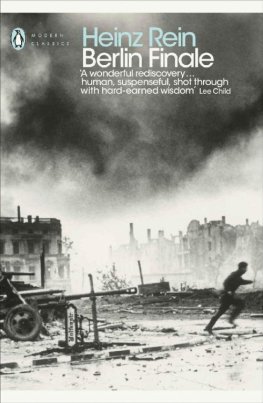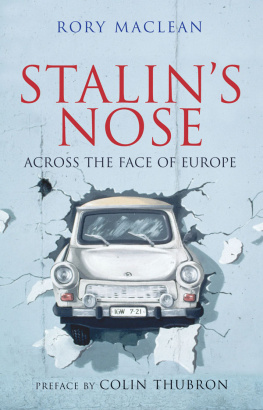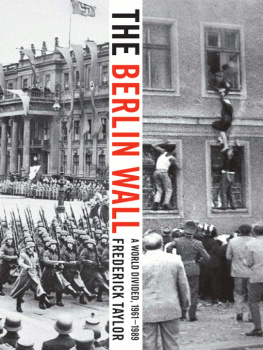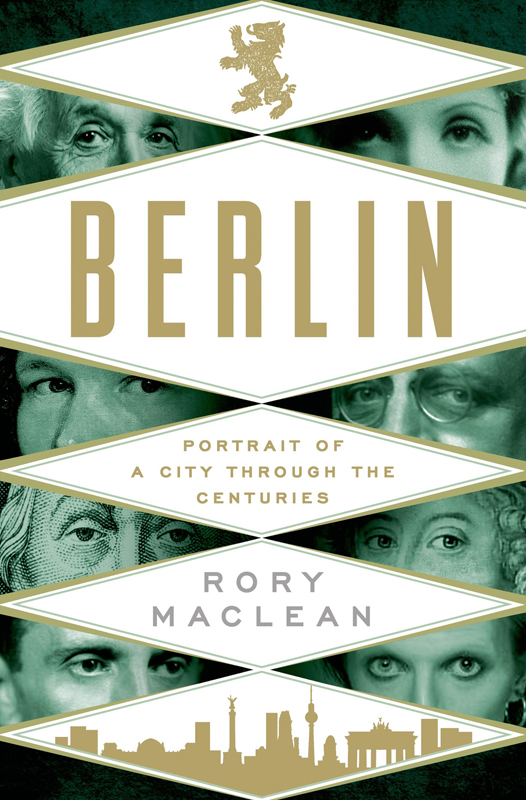Contents
Guide

The author and publisher have provided this e-book to you for your personal use only. You may not make this e-book publicly available in any way. Copyright infringement is against the law. If you believe the copy of this e-book you are reading infringes on the authors copyright, please notify the publisher at: us.macmillanusa.com/piracy.
CONTENTS
The past is never dead, in fact its not even past.
Christa Wolf
PROLOGUE
Imagine
Dawn casts the shadow of a vanished palace upon the mist. A kings flute solo drifts on the air. Saplings take root on the forgotten railway siding where Lenin paused before sparking his revolution. Victory flashes gold through the thick Tiergarten trees. Ashes from Sachsenhausens ovens are caught in dusty whirlwinds above the Holocaust Memorial. Childrens laughter echoes along narrow, naked parks where the Wall once stood. In a banal car park, tourists stand, transfixed, atop Hitlers hidden bunker.
Why are we drawn to certain cities? Perhaps because of a story read in childhood. Or a chance teenage meeting. Or maybe simply because the place touches us, embodying in its tribes, towers and history an aspect of our understanding of what it means to be human. Paris is about romantic love. Lourdes equates with devotion. New York means energy. London is forever trendy.
Berlin is all about volatility. Its identity is based not on stability but on change, as wrote historian Alexandra Richie. No other city has repeatedly been so powerful, and fallen so low. No other capital has been so hated, so feared, so loved. No other place has been so twisted and torn across five centuries of conflict, from religious wars to Cold War, at the hub of Europes ideological struggle.
Berlin is a city that is forever in the process of becoming, never being, and so lives more powerfully in the imagination. Long before setting eyes on it, the stranger feels its aching absences as much as its brazen presence: the sense of lives lived, dreams realised and evils executed with an intensity so shocking that they rent the air and shook its fabric. So much of it has been lost or reinvented that the mind rushes to fill the vacuum, fleshing out the invisible, linking facts with fiction. As neither are fixed, an animated dialogue sparks between present and past, between the observed city and the place portrayed in ten thousand books, films, paintings and fanciful architectural utopias. Yesterday echoes along todays streets and the ideas conjured up by Berlins dreamers and dictators seem as solid as its bricks and mortar. The hypnotic and volatile city comes alive in the mind.
* * *
A lifetime ago I was a teenage traveller doing Europe. During a happy, footloose summer I climbed the Eiffel Tower, tripped down the Spanish Steps and felt the earth move under the stars on an Aegean beach. Then on the last week of the holiday I saw the Wall. The sight of the heinous barrier shook me to my core. At the heart of the Continent were watchtowers, barbed wire and border guards instructed to shoot fellow citizens who wanted to live under a different government.
I knew the history. I understood what had happened. But I couldnt conceive how it had happened. The individuals whose actions had divided Germany and Europe the wartime planners, the Soviet commissars, the Stasi agents werent monsters. They were ordinary men and women. I longed to understand their motivation, how they came to act as they did, yet at the same time I was repulsed by their crimes and needed to feel their victims suffering.
Throughout that week I was drawn again and again to the Wall. I stood for hours on the wooden observation platform at the end of a bizarre cul-de-sac overlooking vanished Potsdamer Platz. I stared in silence across the death strip, stunned that a clash of ideas could be set in cement at the centre of a city.
Then on the final day of the holiday I crossed into the East. At Checkpoint Charlie I stepped over a white-painted line and slipped through a gap in the Wall. Gates lifted then closed behind me. Cars and pedestrians were corralled into a concrete chicane of sharp double bends. A Soviet MiG flew low over the deserted Brandenburg Gate, touching the sound barrier, shaking the windows and my faith in the inherent goodness of man.
I surrendered my passport to an armed, buttoned-up officer, paid for a visa and stood in the drizzle under the gaze of a Volksarmee lieutenant dressed in field grey. He carried a loaded rifle. Beyond his squat lookout post, the doors of the surrounding buildings had been bricked up. The entrances to underground stations were sealed. Along Friedrichstrae once the bustling Fleet Street of Berlin stretched a bleak and narrow transit route of flat concrete-rendered faades, from which residents and memories had been sucked away.
On that last and first day I walked away from the tightly controlled border area and made for windswept Alexanderplatz. I carried with me a collection of Alfred Dblins 1920s short stories. Before the war and Wall, Berlins greatest biographer had wandered through the central squares cobbled courtyards and cloth shops, noting the idle youths in cheeky caps, the clockmakers and the very cheap women. Around him locals had called out in guttural Yiddish. Fishmongers had sold fat herring on ice, chalking price lists on the cellar doors of their high, angular houses. Fairground barrel organs had clamoured outside the Mnzstrae cinemas. Above a workers bookshop a painted hand had rested on an open book, beneath a sickle, ears of corn and the words, To produce more you need to know more.
But in the 1970s the monstrous expanse of grey concrete offered me no hint that fifty years earlier it had been Dblins quivering heart of Berlin. Almost nothing had survived of the old town, due to the combined efforts of Albert Speers fantasies, British Lancaster bombers and Communist city planners. Around me I heard neither voices nor birdsong. The tiled Fountain of Friendship among People was bone dry. The cavernous, colourless Centrum department store seemed to sell nothing but Russian Melodiya LPs. Smudges of brown coal smoke hung in the air and the blackened station smelt of blast dust. A maroon and beige S-Bahn train rattled over the arches. I clutched my book so tightly that my knuckles turned white. Alexanderplatz appeared to be deserted, apart from a young couple pushing a pram. Beneath the tarnished World Clock in which planets jerked like dying atoms around a nuclear centre they paused to adjust the babys blanket. I glanced into the pram. Their baby was a plastic doll.
A single building of human proportion caught my eye. On the squares western edge beyond a tram shelter, the Marienkirche was Berlins second parish church, built on a sandy rise in an unknown year during the thirteenth century. Its canted angle alone echoed the old street plan. Yet as I darted towards it I saw that bullet holes still peppered its old brick walls. The mingy light which seeped through its dirty windows dragged the spirit down into the lurking shadows, instead of drawing it up to heaven. In its doorway a lone woman shivered in her bare stockings as a cobbler whetted his knife and shaped the new heels of her boots.
Death stood in the vestibule behind them. He seized the hands of cardinal and pope, king and knight, magistrate and fool, and led them on their last journey. I moved with them into the body of the church, along the length of the pale, twenty-metre Gothic mural. The Totentanz had been painted with childlike simplicity around 1469 and survived blitz, firestorm and agnosticism, hidden under whitewash for almost half a millennium. Its awkward line of dancers had been invisible when for example Nietzsche had walked past them and first felt Berlins hidden will to death. Goethe, Voltaire and the Brothers Grimm had followed him into the Marienkirche, sensing rather than seeing the Totentanz , as had visitors and residents Chekhov, Kafka, Dblin, Nabokov and Gnter Grass. In this same vestibule Anita Berber the black-lipped erotic dancer painted by Otto Dix had been stirred to create her own naked death dance and Nick Cave had paused, hearing in his head the lyrics of Death is Not the End. During his sojourn in the city Jean-Paul Sartre may even have imagined here a world where the dead lived alongside the living, unseen by them and unable to touch them.



